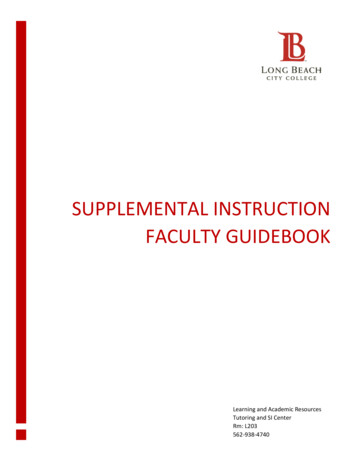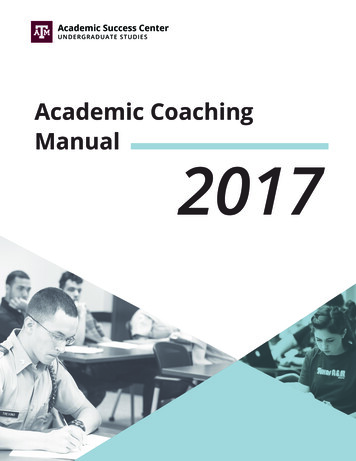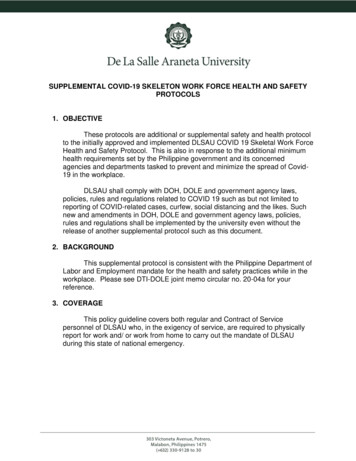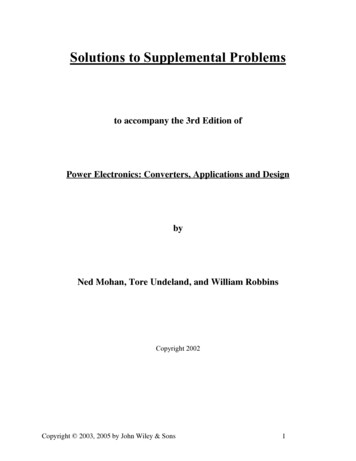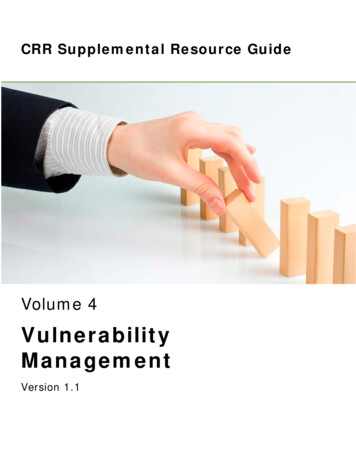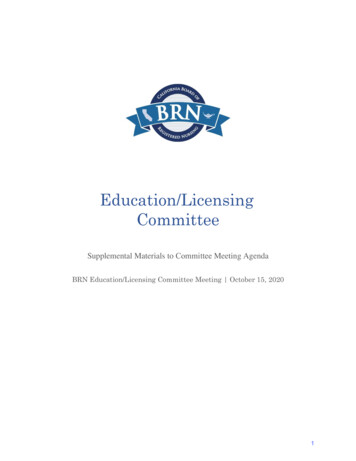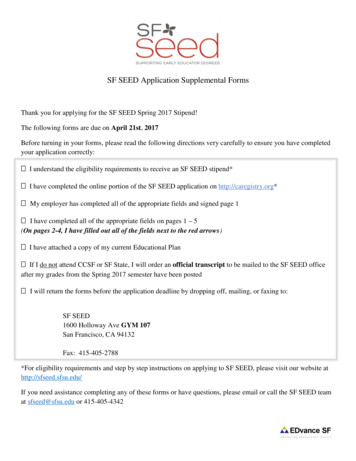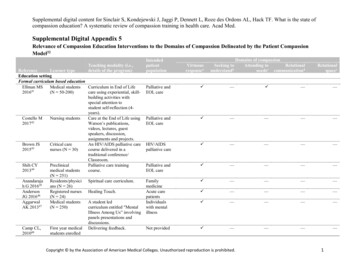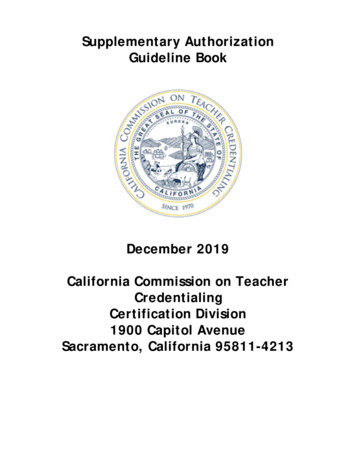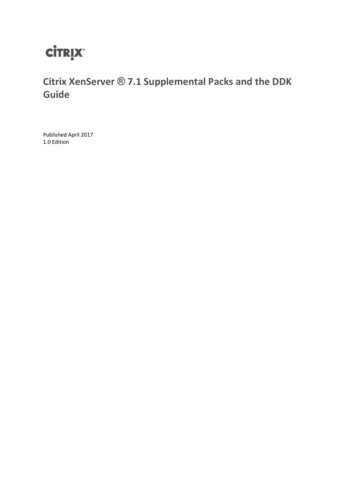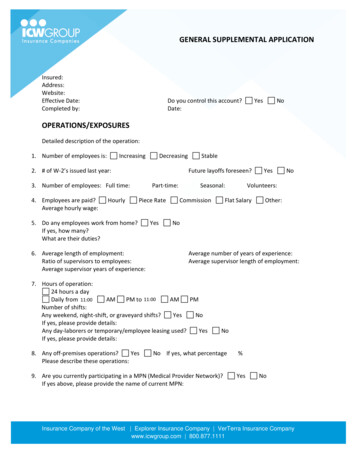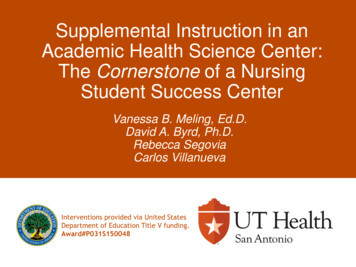
Transcription
Supplemental Instruction in anAcademic Health Science Center:The Cornerstone of a NursingStudent Success CenterVanessa B. Meling, Ed.D.David A. Byrd, Ph.D.Rebecca SegoviaCarlos VillanuevaInterventions provided via United StatesDepartment of Education Title V funding.Award#P031S150048
The School of NursingVisionWe make lives better by promoting health as an act ofsocial justice.MissionWe develop nurse leaders to improve health and healthcare, through education, research, practice, and communityengagement.
Institutional ContextUT Health San AntonioSchool of Nursing Hispanic-serving Institution that isone of five professional schoolsMajority under-representedenrollment with a BSN populationthat identifies as 42% Hispanic Fall 2017 enrollment was 554undergraduate and 242 graduate Nursing shortage and a shortageof diverse nurses and faculty First-time pass rates on NCLEXRN slipped below 80% for twoconsecutive years – placed theSchool on warning with the TexasBoard of Nursing
Providing Academic SupportThe Student Success Center Prior to 2014, support wasprovided by Juntos Podemos –Services were limited andfunding was lostFocus groups of each cohortwere conducted to identify theneeds and barriers identified bystudentsThis study identified five keythemes that illuminated theneed for enhanced instruction,faculty engagement, and accessto study skill resources
A CentralizedStudent Success Center The SON Student Successopened in fall 2014 Learning Space dedicatedfor the SSC 1 staff member; 0 budget Lacking academic support BSN Nursing curriculumand Health ScienceInstitution Become Learners First –Be inquisitive
ASSESSIdentifying the Problem Seek out the barriersto nursing studentsuccess Data Collected:Student Feedback Cohort Focus Groups SON SatisfactionSurveys
DIAGNOSEWhat are the findings?Theme 1Faculty Instruction &In-Course DecisionsTheme 2Variation amongClinical ExperiencesTheme 4Anxiety caused bythe nature of theCurriculumTheme 3Perceived need foradditional resourcesTheme 5Imbalance betweenExpectations &Available Time
PLANNINGNarrowly-Tailored achingFacultySupportStudent kshopsPeerMentoringFamilyEngagementFiesta
IMPLEMENTThe Actionable Part Faculty Reception of high-riskcourses to inform them on SIprogram Analyze & Coordinatenursing schedule Select, hire, and train SILeaders Marketing & Promotion Budget – seek extramuralfunding
EVALUATEAre you meeting objectives? Increased learning, coursecompletion, and academicsuccess Impact on Licensure PrepOutcomes Increased Board Exam(NCLEX-RN) Pass rates Met objectives
A NURSING PROCESS(ADPIE)
Collaborative Discussion1. Individually take time to reflecton your institution, students,and/or SI program2. Write down preliminary notesfor each ADPIE step3. Discuss with a partner or yourtable how you could applyADPIE steps to develop a newSI program, enhance your SIprogram, or make SI thecornerstone of your learningcenter.
SON Supplemental Instruction ResultsSupplemental Instruction Attendence FA2015Class EnrollmentSP2016SU2016FA2016Number AttendedSP2017SU2017Percent AttendedFA2017
SON SI WorksMean Grades for Students AttendingSupplemental Session versus Not n Grade non-SI3.43Mean Grade SP2016SU2016FA2016SP2017SU2017FA2017
Student Feedback on SI “The SI Leaders are amazing! They were able to break down material so it iseasier to understand. They are always so happy to help and they are open toany questions that relate to the material without making students feel sillyfor asking.”“Each of the SI leaders played an important role in my success in pharm[Pharmacology]. Each of them brought a different way to think about theinformation. Each of the sessions covered pertinent information in a wellorganized fashion.”“I would not have passed ATI or earned an A in the class without the help ofthe SI Leaders. This is vital for the success of nursing students.”“I definitely learned a lot in just that short amount of time. Their sessionsgave a lot of direction and pointed out important topics that I may haveoverlooked had I not gone.”
NCLEX-RN Pass RatesYear UT HealthTexasNationalNCLEX Pass Rates 125 86.6175 85.7987585Pass Rate %1410080UT Health75State70National6560555014151617
Questions
Thank You
enrollment with a BSN population that identifies as 42% Hispanic Fall 2017 enrollment was 554 undergraduate and 242 graduate Nursing shortage and a shortage of diverse nurses and faculty First-time pass rates on NCLEX-RN slipped below 80% for two consecutive years –pla
